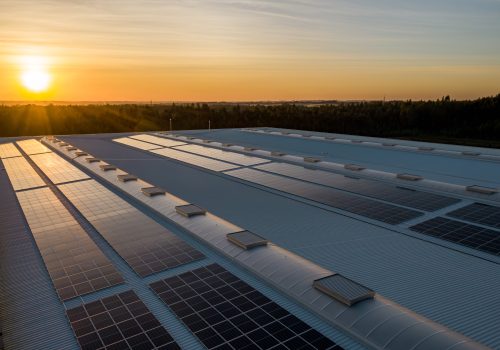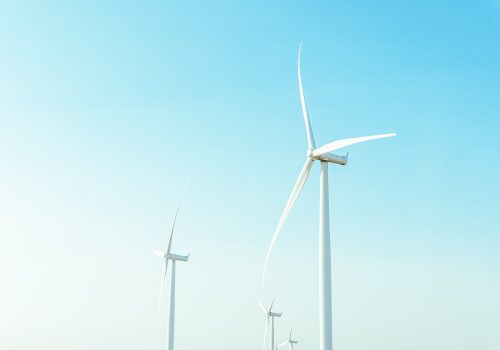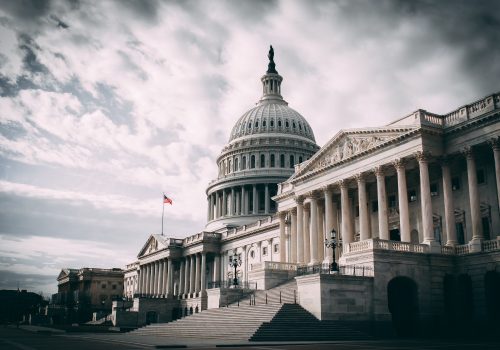The Inflation Reduction Act’s (IRA) elevation of clean energy technologies will erode domestic hydrocarbon demand. Counterintuitively, the law will also bolster US oil and gas exports.
The law not only strengthens US leadership in global decarbonization efforts—it also makes the United States an even more powerful actor in oil and gas geopolitics.
The IRA’s impact on oil markets
The IRA has had little real impact on US oil production—so far. Since last August, US crude production has risen only slightly, by 0.68 million barrels per day (bpd) to 12.67 million in May. Over time, however, the IRA will lower oil product demand for light-duty vehicles.
US gasoline demand totaled 7.9 million bpd in 2022 and almost certainly peaked in 2018. Recent declines are largely a function of prices and the increasing fuel efficiency of the US light duty vehicle fleet. Still, IRA provisions for electric vehicles (EVs) will curb gasoline demand further, especially as older, less efficient models exit the US vehicle fleet.
Since US EVs typically displace fuel-efficient sedans, their impact on overall gasoline demand has been modest to date. As EVs reach other parts of the fleet, such as light-duty trucks and sport utility vehicles, their impact could be more significant.
One study from June 2022—before the IRA–found EVs would reduce US gasoline demand nearly 1 million bpd by 2030. If the IRA is successful in boosting EV uptake, the implications for gasoline demand could be profound.
Domestic demand down, exports up
Declining US demand makes oil exports more attractive for industry. A Princeton study found that, because of the IRA, US crude and refined product exports could increase 18 to 62 percent by 2030. By reducing domestic consumption and expanding exports, the IRA could ensure the United States and Canada—the number-one source of US oil imports—become even more powerful actors in global oil markets.
US officials may have taken note. Federal regulators approved the Sea Port Oil Terminal (SPOT) project in Texas last November, boosting US oil export capabilities by a massive 2 million bpd. SPOT’s ability to service very large crude carriers (VLCCs), which enjoy lower per-unit transportation costs, will enhance the competitiveness of US exports.
The construction of SPOT–and potentially other VLCC-capable terminals–will do more than improve US oil export capabilities. It will make the United States a hydrocarbon export superpower to the benefit of US partners and allies.
The IRA will free gas molecules for export, too
The IRA will also increase US influence in natural gas markets. The United States is already a major gas exporter, via liquefied natural gas (LNG) shipments and pipeline exports to Mexico and Canada.
By reducing US natural gas demand through decarbonization, the IRA will encourage further exports. Furthermore, the IRA’s charge on methane emissions will improve the emissions profile of US gas, making cargos more competitive in climate-conscious markets like Europe.
US natural gas is used almost entirely in electricity, industry, and heating. The IRA’s impact will be felt most acutely in the power sector, as support for clean energy chips away gas’ share of the energy mix.
The IRA will also accelerate clean hydrogen adoption, displacing gas consumption for industrial processes. Finally, IRA incentives for heat pumps and building retrofits will curtail natural gas demand for heating. In 2022, heat pump sales exceeded gas-powered furnaces for the first time–even before the IRA went into effect.
In the near-term, however, US natural gas is riding high. Production has increased by 3.8 billion cubic feet per day (Bcf/d) since the IRA’s passage, now standing at 103.1 Bcf/d. Consumption shows continued signs of strength.
Expectations that the IRA would curtail domestic demand, thereby motivating LNG investment, have been borne out. Three US LNG projects with nameplate capacity of 5.1 Bcf/d reached final investment decision in 2023, an annual record.
While the viability of US LNG exports has been shaped first and foremost by Russia’s invasion of Ukraine and the corresponding impact on European gas markets, the IRA offers medium and long-term support for natural gas exports, incentivizing LNG investment.
The IRA is reducing emissions while improving allies’ energy security
The IRA is supercharging US decarbonization efforts. While much work remains, the United States is taking massive strides to decarbonize its electricity, heating, industrial, and transportation sectors.
The IRA’s geopolitical consequences, while less prominent, are just as important. By reducing domestic hydrocarbon demand, the IRA is encouraging the US oil and gas industry to seek out more lucrative export markets in Europe and the Indo-Pacific. The IRA will therefore increase US influence in global oil and gas affairs, ensuring other democracies are less reliant on competitors and adversaries.
Joseph Webster is a senior fellow at the Atlantic Council’s Global Energy Center. He also edits the China-Russia Report. This article represents his own personal opinion.
Meet the author
Related content
Learn more about the Global Energy Center

The Global Energy Center develops and promotes pragmatic and nonpartisan policy solutions designed to advance global energy security, enhance economic opportunity, and accelerate pathways to net-zero emissions.
Image: Aerial photograph of an oil tanker, courtesy of Shaah Shahidh, UnSplash (https://unsplash.com/photos/-subrrYxv8A)






